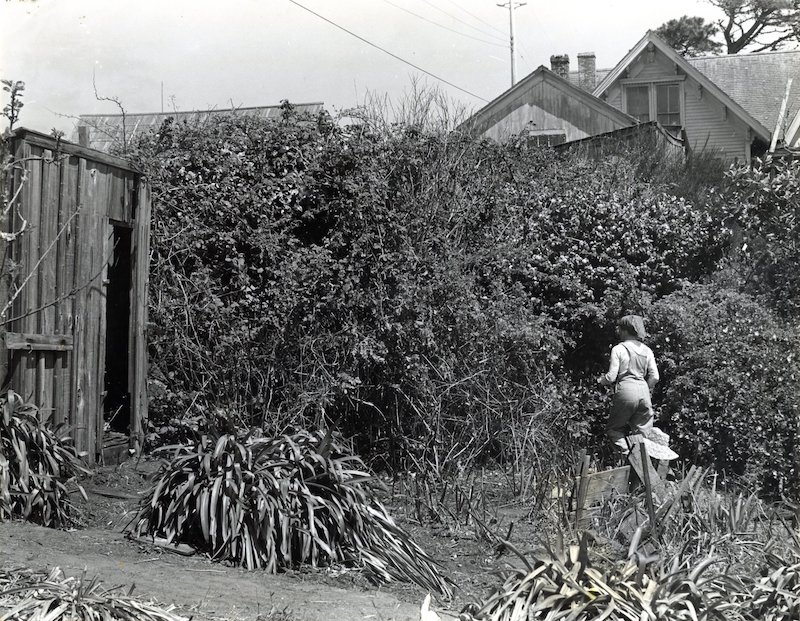The following excerpts originally appeared in the Mendocino Beacon on April 17 and May 1, 1975. The authors are unknown.
April 17, 1975
The Kelley House began its new life as Mendocino Historical Research, Inc. (MHRI) headquarters on April 5, 1975. That was the day Robert O. Peterson presented the deed to the board of directors.
[MHRI was founded by Dorothy Bear and Beth Stebbins and incorporated on November 27th, 1973. Peterson was the founder of the Jack-in-the-Box fast food chain and the then owner of the Mendocino Hotel.]
Almost immediately three workers, experienced gardeners, donned heavy gloves and long sleeves and started clearing the grounds. Under the thick tangle of blackberry vines and long overgrown shrubs, they found old walkways, camellia bushes as tall as trees, little wire fences marking off garden areas, old-fashioned rose bushes with branches 10 feet long, and an old tool shed.

Frances Casey, gardener for the Kelley House in the early years of its restoration. Frances is cutting down the overgrown blackberry plants and other weeds in what was called “the secret garden,” located just behind the Albion Street fence and above the pond. A small wooden garden shed is on the left, and the roof and west elevation of the Kelley House is visible behind the tall camellia bushes.
By the end of April or sooner, if possible, the directors hope to welcome visitors to the room downstairs, the northeast room, which is to become the office and library. In the meantime, one may read about the history of the Kelley House in the Mendocino Historical Review. The spring issue is a special edition devoted to the Kelley family, the house, and plans for it.
[A copy of the issue, no longer in print, is available to peruse in the 50th Anniversary Exhibit, Kelley House Museum: Building a Home.]
May 1, 1975
Day by day, as the blackberry vines give way to the clippers and mattock, a picture emerges of the garden that was. It is now known where the “kitchen garden” was planted: Dorr Bothwell [an artist who came here in 1961] remembers the rows of cabbages.
The pink Duchess rose by the kitchen door is almost as old as the house. To the west of the house on Albion Street is a small shed and near it are two rose bushes, one very dark pink called American Pillar, one of the very first roses (information from the Kelley family). The gardeners were not able to find the “Grosmutter” white rose planted by Eliza Kelley many years ago.
Plans for the restoration of the house will, as far as possible, include the grounds.
Engineering plans for restoration of the house are completed. Applications for permits have been made to the Historical Review Board and the Coastal Commission and MHRI finds no difficulty in complying with their requirements. Bids are coming in for painting and replacement of broken or lost ornaments. Francis Jackson is general contractor for the restoration and is assessing the first order of work which will be the foundation. Progress will depend upon availability of funds.
AND DID YOU NOTICE? MONDAY, JOHN ZUNINO MOWED THE GRASS. AS A DONATION.
[Some tasks are perpetual; the care and upkeep of our beautiful grounds is one of them. If you can volunteer as a gardener or contribute to our gardening funds, please contact the museum.]
The Kelley House Museum is open from 11AM to 3PM Thursday through Monday. If you have a question for the curator, reach out to curator@kelleyhousemuseum.org to make an appointment. Walking tours of the historic district depart from the Kelley House regularly.